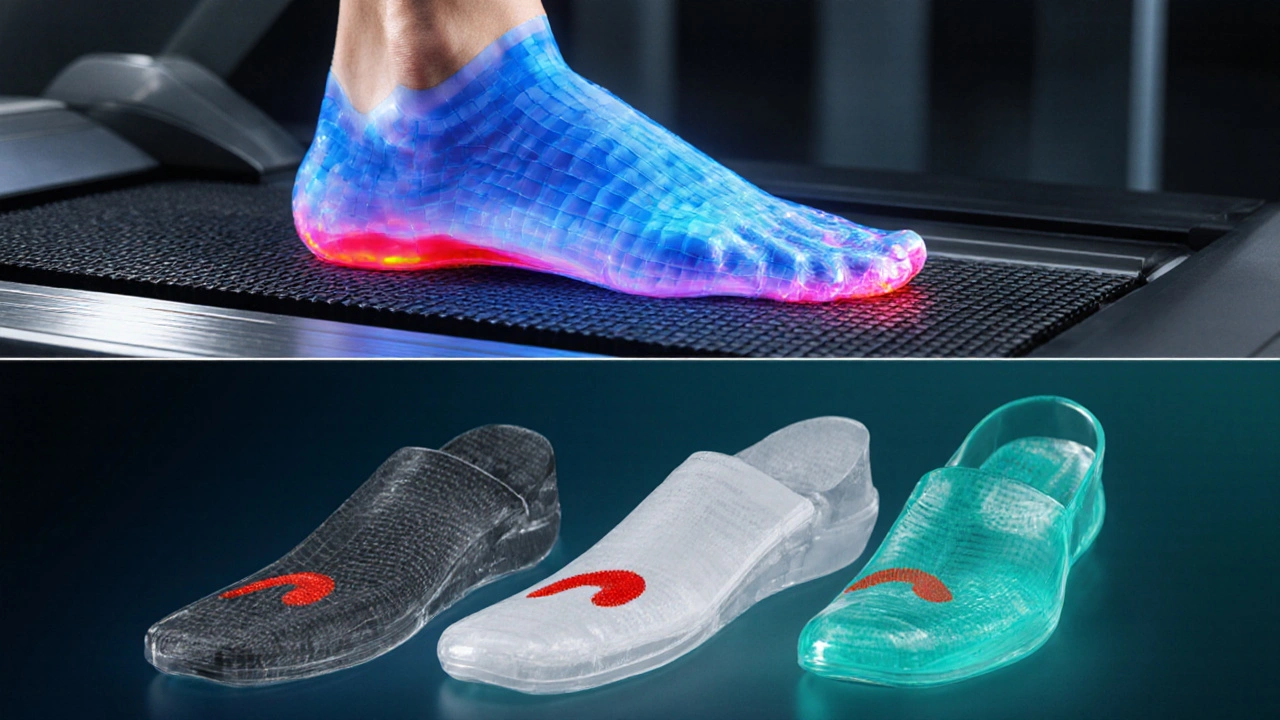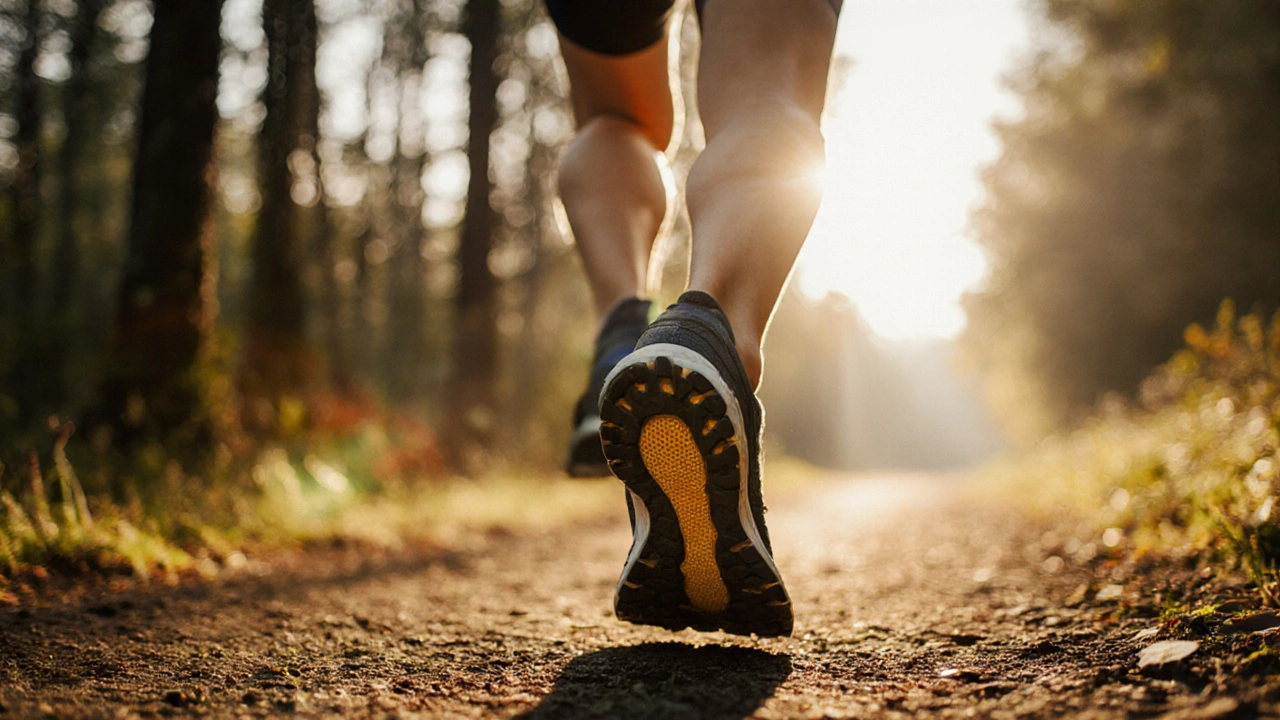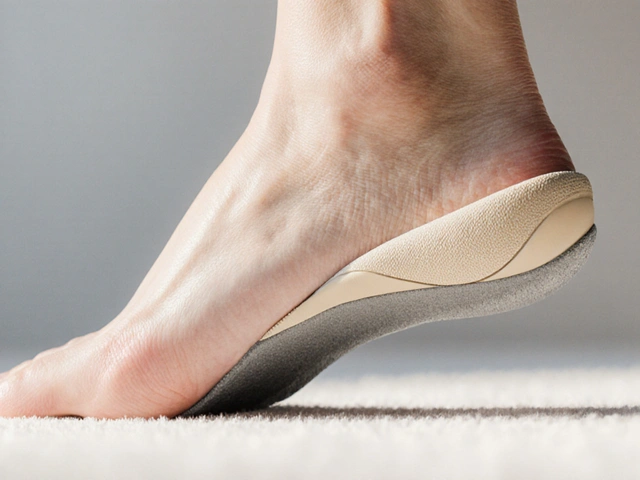Orthotics for Bursitis: Feature Checker
Recommended Orthotic Features
Arch Support
Cushions the medial longitudinal arch to limit excessive pronation that causes heel-bursa friction.
Heel Cushioning
Absorbs impact forces during heel-strike, reducing compression on the retrocalcaneal bursa.
Pressure Redistribution
Strategically places load across metatarsal heads to protect sub-metatarsal bursae.
When it comes to foot health, Orthotics are shoe inserts-either custom‑made or prefabricated-designed to support, align, or correct the foot and lower‑limb biomechanics. They work by redistributing pressure, improving alignment, and reducing strain on soft tissues. If you’re looking for a simple way to protect your joints, orthotics can make a big difference, especially when it comes to keeping bursitis at bay.
Quick Takeaways
- Orthotics balance foot biomechanics, which lowers inflammation in bursae.
- Custom orthotics provide the most precise fit and highest bursitis‑prevention score.
- Key features to watch for are arch support, heel cushioning, and pressure‑redistribution zones.
- Gait analysis helps you pick the right orthotic type for your activity level.
- See an orthopedic specialist if pain persists after 2‑3 weeks of orthotic use.
What Are Orthotics?
Orthotics can be split into three broad categories: rigid, semi‑rigid, and soft (often called gel or foam). Rigid inserts keep the foot in a fixed position, ideal for severe overpronation. Semi‑rigid options offer a balance of support and flexibility, while soft orthotics provide cushioning for low‑impact activities. The choice depends on your foot shape, activity level, and the specific bursitis‑related stress points you want to protect.
Understanding Bursitis
Bursitis is inflammation of a bursa-small fluid‑filled sacs that cushion bones, tendons, and muscles near joints. In the foot and ankle, the most common sites are the retrocalcaneal bursa (behind the heel) and the sub‑metatarsal bursae (under the ball of the foot). When these sacs become irritated-often from repetitive friction or poor alignment-they swell, causing sharp pain, stiffness, and limited mobility.

How Foot Biomechanics Influence Bursitis
Foot biomechanics refers to the way your foot moves and bears weight during standing, walking, or running. Poor biomechanics-such as overpronation (excessive inward roll) or supination (excessive outward roll)-force the heel and forefoot into abnormal positions. This misalignment creates extra shear forces on the bursae, accelerating inflammation. Studies from the Australian Podiatry Association (2024) show that athletes with unchecked overpronation are 2.3 times more likely to develop retrocalcaneal bursitis.
Types of Orthotics: Custom vs Over‑the‑Counter
When choosing an orthotic, the main decision point is whether to go custom‑made or buy an over‑the‑counter (OTC) pair. Both have pros and cons, and the right choice hinges on the severity of your biomechanics and your budget.
| Feature | Custom Orthotics | Over‑the‑Counter Orthotics |
|---|---|---|
| Cost (AU$) | 300‑600 | 30‑100 |
| Material | Thermoplastic, EVA, carbon‑fiber blends | Foam, gel, basic plastic |
| Fit | 3‑D molded to your foot shape | One‑size‑fits‑most or size‑specific |
| Longevity | 3‑5 years (with proper care) | 6‑12 months |
| Effectiveness for Bursitis Prevention | High - tailored pressure redistribution | Moderate - generic arch support |
If you have a history of chronic bursitis or a diagnosed biomechanical fault, custom orthotics are usually worth the investment. For occasional plantar discomfort or mild misalignment, a quality OTC pair can still provide meaningful relief.
Key Features That Help Prevent and Relieve Bursitis
- Arch support cushions the medial longitudinal arch, limiting excessive pronation that drags the heel‑bursa into friction.
- Heel cushioning absorbs impact forces during heel‑strike, reducing compression on the retrocalcaneal bursa.
- Pressure redistribution zones strategically placed under the forefoot spread load across the metatarsal heads, protecting sub‑metatarsal bursae.
- Gait analysis technology (often available at podiatry clinics) identifies abnormal stride patterns and informs orthotic design.
- Material breathability - moisture‑wicking liners prevent skin irritation that can aggravate inflamed bursae.

Choosing the Right Orthotic - A Practical Checklist
- Identify your primary pain site (heel vs ball of foot).
- Get a professional foot assessment-ideally a podiatrist or orthopedic specialist.
- Ask whether a 3‑D scan or a standard foot impression best captures your shape.
- Match the orthotic material to your activity level (rigid for high‑impact sports, semi‑rigid for daily wear).
- Check for built‑in arch support and heel cushioning specifically labeled for bursitis relief.
- Confirm the return‑policy; you may need a brief trial period to gauge comfort.
- Consider a break‑in schedule-start with 15‑20 minutes daily, then increase to full‑day wear.
When to See an Orthopedic Specialist
Orthopedic specialist is a medical doctor who diagnoses and treats musculoskeletal conditions, including persistent bursitis. Schedule a visit if:
- Pain persists beyond three weeks despite orthotic use.
- You notice swelling that doesn’t subside with rest and ice.
- Walking or running feels unstable, suggesting an underlying structural issue.
- Conservative measures (stretching, NSAIDs, orthotics) provide only temporary relief.
The specialist may recommend corticosteroid injections, physical therapy, or, in rare cases, surgical bursectomy. Early intervention often prevents chronic degeneration.
Putting It All Together: A Sample Relief Plan
- Day 1‑3: Rest the affected foot, apply ice 15minutes three times daily, and start a short anti‑inflammatory regimen (e.g., ibuprofen 400mg after meals).
- Day 4‑7: Begin wearing an OTC orthotic with heel cushioning for short walks (10‑15minutes). Perform gentle calf‑stretch and toe‑flex exercises twice daily.
- Week 2‑3: If pain drops by ≥50%, upgrade to a custom orthotic based on a gait‑analysis report. Increase walking time by 10% each session.
- Week 4: Evaluate progress. If swelling remains or pain spikes, book an appointment with an orthopedic specialist.
Following this step‑wise approach lets you capitalize on the biomechanical benefits of orthotics while keeping a safety net for more serious issues.
Frequently Asked Questions
Can I use the same orthotic for both feet?
Even if your shoes feel similar, most people have subtle asymmetries. Custom orthotics are molded individually for each foot, while quality OTC pairs usually come in left/right versions to account for basic differences.
How long should I wear orthotics each day?
Start with 15‑30minutes and gradually increase to full‑day wear as comfort improves. Most users find 6‑8hours sufficient for bursitis prevention.
Will orthotics cure existing bursitis?
Orthotics can dramatically reduce the forces that keep a bursa inflamed, helping symptoms subside faster. However, acute inflammation often needs complementary treatment-rest, ice, and anti‑inflammatories.
Are there any activities I should avoid while using orthotics?
High‑impact sports like mountain biking or aggressive basketball can stress the orthotic material before it fully breaks in. Limit those activities for the first two weeks, or use sport‑specific inserts if you need full performance.
How often should I replace my orthotics?
Custom orthotics typically last 3‑5years, while OTC versions need replacement every 6‑12months, especially if you notice loss of cushioning or visible wear.


Lydia Conier
October 8, 2025 AT 14:14Hey folks, great rundown on orthotics and bursitis!
If you're just starting out, remember that a proper gait analysis can save you a lot of hassle down the line.
Even a small mis‑alignment can turn a simple walk into a painful marathon, so take the time to get your feet measured.
Custom orthotics might seem pricey, but think of them as an investment in your mobility-your knees will thank you later.
Also, dont forget to break them in slowly; start with 15‑20 minutes and work your way up.
Lets keep supporting each other and share any brand recommendations you’ve tried!
ruth purizaca
October 23, 2025 AT 15:20Wow, another generic guide for the masses.
Shelley Beneteau
November 7, 2025 AT 16:27I appreciate the thoroughness, especially the table comparing custom and OTC options.
The emphasis on gait analysis aligns with what many clinicians stress in practice.
Just a reminder that cultural factors can affect how patients perceive foot pain and treatment.
Sonya Postnikova
November 22, 2025 AT 17:34Super helpful post! 😊
Honestly, I was skeptical about orthotics at first, but after trying a semi‑rigid pair I felt a noticeable drop in heel pain.
Remember to give them a gradual break‑in period, and don’t be afraid to tweak the fit with a podiatrist.
Keep the optimism flowing, and happy walking!
Anna Zawierucha
December 7, 2025 AT 18:40Oh great, another shiny advertisement for "miracle" foot inserts.
Because nothing says "I care about my health" like throwing a few dollars at a plastic insole and calling it a day.
But hey, if it stops your toes from feeling like a broken pretzel, go for it.